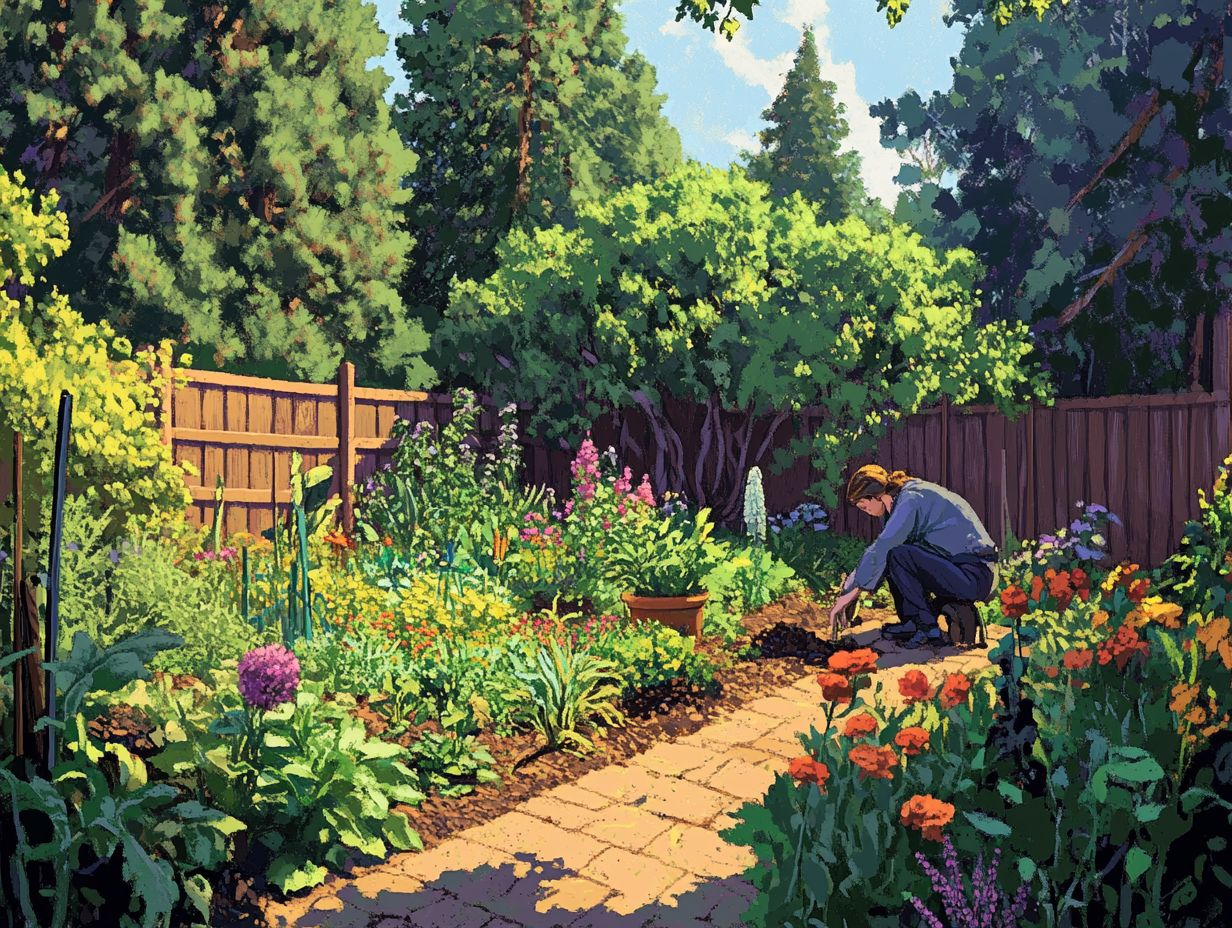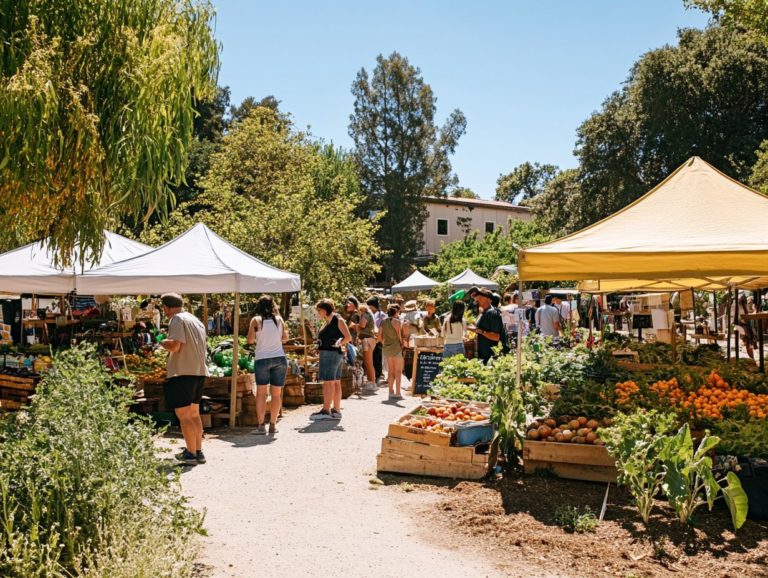How to Choose the Right Location for Your Garden?
Choosing the ideal garden location for your vegetable garden is crucial for its success and your enjoyment. Consider factors like climate, soil quality, available space, and sunlight, all of which contribute to a thriving garden.
Get ready to discover the key elements you should consider, design tips to optimize your layout, common pitfalls to avoid, and alternative garden locations that fit seamlessly into your lifestyle for enhanced gardening convenience.
Embark on a journey to cultivate your green thumb with confidence and ease!
Contents
- Key Takeaways:
- Key Factors for Choosing the Perfect Garden Location
- Designing Your Garden Layout
- Common Mistakes to Avoid
- Alternative Garden Locations
- Frequently Asked Questions
- What factors should I consider when choosing the right location for my garden?
- How much sunlight does my garden need to thrive?
- Can I have a garden in a small space?
- Why is soil quality important for my garden?
- What is the best way to water my garden?
- Can I start a garden if I don’t have access to a water source?
Key Takeaways:

- Consider climate, soil, and sunlight when choosing a garden location to ensure plant growth and health.
- Maximize space and sunlight in your garden design for optimal plant growth and a functional, aesthetically pleasing layout.
- Avoid common mistakes like choosing the wrong location and not planning for future growth and maintenance.
Key Factors for Choosing the Perfect Garden Location
Selecting the ideal location for your vegetable garden is vital to its success. You need to think about sunlight exposure for photosynthesis, how well water can move through the soil, and a reliable water supply to support plant growth and health.
Nearby trees may affect airflow and create unwanted shadows. Pollution from urban areas could also compromise soil quality and the overall ease of gardening. By understanding these environmental factors, you pave the way for a flourishing garden that thrives in its ecosystem.
Climate and Weather Patterns
Understanding climate zones and weather conditions is essential when planning your vegetable garden, as these factors directly influence plant growth and your overall gardening success, especially in drought conditions.
Different regions showcase various temperatures, humidity levels, and rainfall patterns, which dictate the types of vegetables that flourish in each area. For instance, in a cooler climate, hardy vegetables like kale and carrots thrive, while warmer zones are better for heat-loving plants such as tomatoes and peppers. The growth cycles of these vegetables can vary significantly, presenting challenges like drought that can impact yields.
To navigate these weather-related challenges, you can adopt strategies like mulching, implementing drip irrigation, and selecting drought-resistant varieties. Doing so can safeguard your garden and ensure a bountiful harvest, even amidst changing environmental conditions.
Soil Quality and Composition
Soil quality and composition are crucial to your garden’s success, as nutrient absorption and moisture retention are key for optimal plant growth.
Start with a soil test (a way to check your soil’s health) an invaluable step that reveals the pH levels, nutrient absorption, and overall health of your soil. This analysis empowers you to make informed decisions about necessary soil amendments to enhance both fertility and drainage.
For example, adding compost or well-rotted manure enriches the soil with organic matter, improving its structure and supporting microbial life, which is essential for gardening techniques. Maintaining healthy organic matter levels is crucial; it boosts plant growth by providing important nutrients and helps retain moisture, ensuring your plants thrive under various conditions.
Available Space and Sunlight
The amount of available space and sunlight exposure is crucial for crafting an effective garden layout and design. This directly influences your gardening experience and the variety of vegetable plants you can cultivate.
To maximize your gardening efforts, assess the dimensions and conditions of your chosen area, including nearby trees and shrubs. Some vegetables thrive in full sun, requiring six to eight hours of direct sunlight daily. Others prefer partial shade, ensuring proper sun exposure for healthy growth. By understanding the specific light requirements of various plants, you can refine your selection process and shape your garden’s overall design.
A well-planned layout that considers garden design allows for efficient spacing and easy accessibility. This ultimately leads to a flourishing vegetable garden that caters to your diverse culinary aspirations.
Designing Your Garden Layout

Designing your garden layout is an artful endeavor. You need to maximize space, ensure adequate sunlight exposure, and curate an aesthetically pleasing environment. This thoughtful approach enhances the beauty of your garden while aligning with your gardening skills and experience.
Maximizing Space and Sunlight
Maximizing space and sunlight exposure is essential for enhancing plant growth in your vegetable garden. Thus, thoughtful garden layout planning should be a priority.
Embrace strategies like vertical gardening and growing different plants together. These techniques are key for utilizing every square foot of your gardening area. Vertical gardening allows plants like peas and cucumbers to climb. This frees up ground space for other vegetables.
Different plant varieties have unique sunlight requirements, which significantly affect their growth potential. For instance, sunflowers can provide shade for leafy greens that flourish in partial sunlight. By integrating these techniques, you’ll cultivate a thriving, productive garden that showcases your best efforts.
Creating a Functional and Aesthetic Design
Creating a functional and aesthetically pleasing vegetable garden requires a careful balance between practical gardening techniques and visual appeal.
Consider layout principles that dictate how plants interact with each other and the overall space. Implementing raised beds can help you maximize space while ensuring efficient drainage and easy access.
Select a color palette that complements your home and surroundings. For example, pairing vibrant greens with the rich hues of vegetables like purple eggplant or deep red tomatoes can be stunning. Incorporate diverse textures, from soft foliage to sturdy trellises, to foster an inviting atmosphere.
By balancing these elements, you will not only please the eye but also enhance utility. This ensures that your garden remains productive and visually striking throughout the growing season, while also considering garden safety.
Common Mistakes to Avoid
Avoid common mistakes to save yourself frustration. Focus on choosing the right location and considering future growth and maintenance needs. These choices can make a significant difference in ensuring your garden flourishes.
Choosing the Wrong Location
Selecting the wrong location for your vegetable garden can lead to insufficient sunlight, a surge in garden pests, and inadequate airflow, which can harm plant health.
A well-chosen gardening site is the foundation for a bountiful harvest. For instance, if nearby trees cast shadows over your garden, your plants may become leggy as they stretch for light. This compromises their vigor and invites pests. Excessive shade creates a humid environment, attracting unwelcome guests like aphids and fostering fungal diseases.
Poor airflow often due to dense plantings or obstructions like fences can hinder pollination and encourage disease by trapping moisture. Finding a spot that is open and bathed in sunlight with proper ventilation is essential for a thriving vegetable garden.
Not Considering Future Growth and Maintenance

Neglecting future growth and maintenance can make your vegetable garden cramped, leading to various gardening challenges. This highlights the importance of thoughtful planning and effective techniques in nurturing a thriving garden.
Practices like crop rotation changing where you plant different crops each season maintain soil health, fend off pests, and boost yields. Spacing is also critical; too-close plants compete for sunlight and nutrients, stifling their growth potential.
This foresight enhances your garden’s visual appeal and streamlines maintenance, making it easier to access plants for weeding or harvesting, while keeping wildlife away. In the end, proactive strategies cultivate a sustainable and flourishing garden ecosystem.
Alternative Garden Locations
Exploring alternative garden locations like indoor gardens, container gardens, and community gardens opens unique opportunities for urban gardeners and those facing space constraints.
Embracing these options allows you to cultivate your green thumb, regardless of surroundings.
Indoor Gardens
Indoor gardens offer a distinctive opportunity to enjoy gardening while ensuring that your plants receive the sunlight they need for growth.
This method allows you to cultivate a diverse array of plants year-round, regardless of outdoor weather. By controlling temperature, humidity, and light, you create an optimal environment for rapid growth and abundant flowering.
The reduced risk of pests and diseases enhances the health of your plants. This approach supports new gardeners as they refine their skills and entices seasoned gardeners eager to experiment with exotic species that thrive indoors.
Container Gardens
Container gardens are a great solution for those with limited space. They allow you to explore various gardening techniques while managing soil quality and moisture retention.
These lush gardens can thrive on balconies, patios, or even in compact urban yards. They are perfect for anyone eager to cultivate their own greenery.
With many options available think elegant clay pots, versatile fabric bags, or innovative self-watering systems you can tailor your gardening experience to fit your needs.
Enhancing your soil with compost or perlite will improve drainage and nutrient levels. Both are crucial for thriving plants.
To cultivate your garden successfully, consider these best practices:
- Choose plants based on their sunlight needs.
- Regularly check moisture levels to strike the right balance.
- Ensure proper drainage to avoid root rot.
This approach makes gardening possible for those with limited space and enhances your overall gardening experience.
Community Gardens
Community gardens offer a fantastic chance to improve your gardening skills. They also foster local engagement and proper plant care.
These vibrant spaces build strong friendships and shared joy in gardening. Participants often share tools and seeds, making gardening accessible for everyone.
Local programs often collaborate with these initiatives, offering workshops that teach sustainable practices and innovative gardening techniques. You ll find that sharing unique experiences enriches collective knowledge and promotes biodiversity the variety of plant and animal life in a habitat.
This way, you cultivate green spaces and contribute to better air quality and urban aesthetics. Community gardening is essential for environmental stewardship.
Frequently Asked Questions

What factors should I consider when choosing the right location for my garden?
Consider sunlight, soil quality, water availability, and space constraints.
How much sunlight does my garden need to thrive?
Most plants require at least 6 hours of sunlight each day. Some, like herbs and leafy greens, can thrive in partial shade.
Can I have a garden in a small space?
Yes! You can garden in a small space by using vertical gardening techniques or growing plants in containers.
Why is soil quality important for my garden?
Healthy soil provides essential nutrients and helps retain moisture. A soil test can determine the pH and nutrient levels.
What is the best way to water my garden?
Water the soil deeply at the base of the plants. Avoid wetting the leaves to prevent diseases. A drip irrigation system can help with efficient watering.
Can I start a garden if I don’t have access to a water source?
Absolutely! Use drought-resistant plants and consider collecting rainwater for irrigation. Mulching can also retain moisture in the soil.






